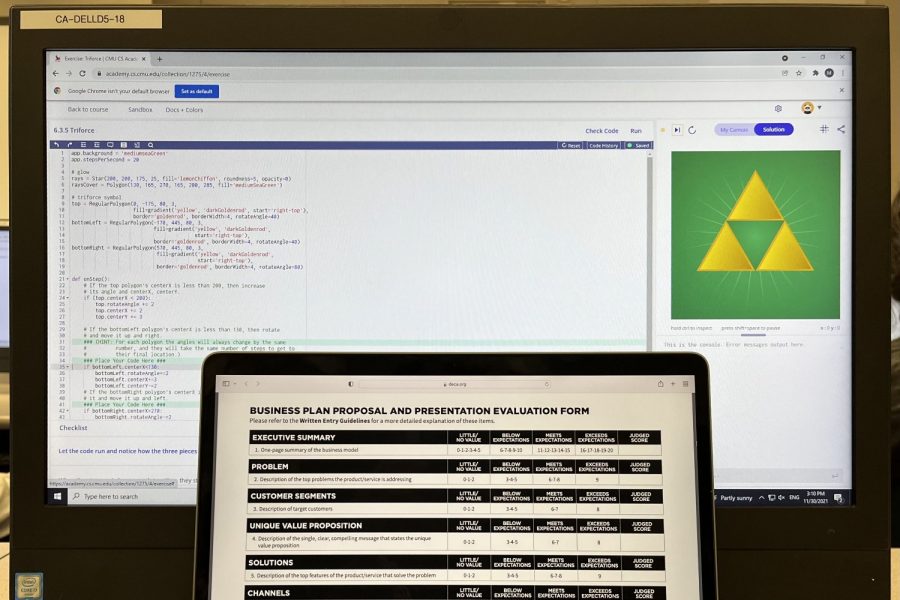As of 2018, 95% of national high school students who concentrated on Career and Technical Education (CTE) courses graduated, according to Advance CTE.
That is almost 10% higher than the current national graduation rate of 85.3%.
Still, many people don’t know what CTE is. According to the National Center for Education Statistics (NCES), CTE consists of courses and programs that focus on the skills and knowledge required for specific jobs or fields of work. CTE courses are beneficial for students and have been proven to prepare students for successful careers in crucial areas of work in the 21st century.
One of the CTE teachers at Carlmont High School is Kristine Govani, who teaches the CTE Intro to Programming Mobile Apps, CTE Advanced Computer Science Structure & Interpretation, and CTE Introduction to Business courses. She has taught solely technology-based classes throughout her entire 16-year teaching career and believes that learning career and technical skills are crucial to everyday life.
“The nice thing about the classes I teach is that those concepts are real-world skills that everybody is going to use immediately. There really isn’t a profession where understanding how computers work and being able to write even simple programs wouldn’t be helpful,” Govani said.
Carlmont offers many CTE pathways to students, such as computer science, business, biotechnology, and digital journalism. These pathways allow students to discover a topic they are passionate about and find a sense of direction in life, a struggle for many students who only take the required courses.
Among the students inspired by a CTE class they took is senior Emma Elliott, who plans to major in computer science. She chose this major after taking the Advanced Computer Science Structure & Interpretation class, which teaches the Python program, and the subsequent AP Computer Science class, which teaches the Java program. Elliott details how taking these two classes influenced her college major decision, a process that can often be very stressful.
“I chose to be a computer science major because I’m interested in machine learning, and I like the structure of computer science in general. In particular, I enjoy how everything fits in a framework, and if you follow the framework, you can get the results you want. However, the main reason I chose to major in computer science is because of the two years of classes I took in the subject,” Elliott said.
Besides the real-world skills gained, there are many other benefits to taking this type of course. The interactive learning environment present in CTE classes also makes them more appealing to students.
“Students like how CTE classes are very hands-on and interactive. It’s fun and different from the rest of the day, and you’re not just sitting there taking notes. I’ve heard some students say to me it’s like a break in the day, but all the content in the class can still be applied to the real world and the future,” Govani said.
The popularity of CTE courses among students can be reflected by the nearly 370,000 high school students in California currently enrolled in a CTE class, according to Advance CTE.
Govani also noted how taking a CTE course in high school is beneficial for students once they reach college.
“Everything students learn in these classes will be used some way or another once they have jobs or go to college. Additionally, pretty much every college, regardless of your subject of study, requires Python or something similar, which gives an advantage to students who took the [Advanced Computer Science Structure & Interpretation] class in high school,” Govani said.
Furthermore, Elliott specified how much she gained from taking the two computer science classes and explained how taking a CTE class thoroughly prepares students for whatever their future holds.
“I learned a lot from these classes, most importantly how to actually problem solve and create a program with a specific goal in mind. I know these lessons will help me in my future career,” Elliott said.
The success and necessity for jobs in CTE-related fields prove the benefits of becoming part of career and technical education. In professions based on CTE pathways, such as computer science or business, the average salary is much higher than the annual average salary for an American adult.
In particular, according to the U.S. Department of Education, high school students who focused on CTE courses had higher average earnings than those who did not eight years after their expected graduations. This suggests that taking CTE programs correlates to a higher income shortly after graduation.
These benefits are coupled with an increased need for these careers as the world becomes increasingly technological and strays away from the popular occupations of years past. Therefore, working in technical professions such as finance and biotechnology is becoming more and more advantageous to the general public and employees, who earn higher wages in these occupations.
The growth of Career and Technical Education has been aided by the U.S. government, which has assisted these programs through many acts of funding.
The history of CTE, first known as vocational education, spans over a century and originated from the Smith-Hughes Act of 1917, where it was initially introduced and federally funded. Legislation towards the improvement of CTE has continued over the next century; notably, the Carl D. Perkins Act of 1984, titled Perkins. The most recent Congress-funded bill was the Strengthening Career and Technical Education for the 21st Century Act signed on July 31, 2018, also known as Perkins V. This was the fifth bill reinforcing the improvement of CTE programs across the nation, and through this act, Congress provides nearly $1.3 billion annually towards CTE programs.
Over time, the passing of various CTE acts has been matched by the growth of these programs in classrooms. Gay Buckland-Murray, the instructional vice principal at Carlmont High School, noted the expansion of CTE courses.
“Recently, we have opened up the Graphic Design and Illustration CTE pathway, along with the mobile apps pathway, giving students more options to choose from,” Buckland-Murray said.
She also hopes to make more CTE courses available to students.
She said, “I wish we had more to offer. It’s something that we’re always looking at, how we can expand our course offerings in the future.”
Carlmont currently offers nine different CTE courses for students, from the Biotechnology 1-2 course to the recently introduced Intro to Programming Mobile Apps course. Taking a CTE course isn’t mandatory for Carlmont students, but they must take a third year of a world language as a substitute for a CTE class.
Despite the numerous benefits of Career and Technical Education, which have been on the upswing for the past decade-plus, these programs’ popularity and knowledge still have room to grow. In a discussion with two of Carlmont’s counselors, they noted how CTE hasn’t yet been required by the state of California, and therefore Carlmont as well. However, they believe a state requirement for CTE is on the horizon, and these programs will continue to develop with funding from Congress.
Buckland-Murray also mentioned the difficulty of expanding CTE course offerings with these classes not being mandated yet.
“The tricky thing is that I can’t just open up one CTE class; it has to have a pathway and lead to something else. In order to do that, I need to have a teacher who’s qualified to teach the subject matter and also has a CTE credential,” Buckland-Murray said.
Overall, states have increasingly supported new career and technical education programs and continue to develop new ones, exemplifying their importance in the eyes of governments. There are many positives of taking a CTE course in high school, including learning in a more interactive environment, getting a headstart on topics learned in college and beyond, and most importantly, developing all kinds of real-world skills necessary in future occupations.
“As a whole, all CTE courses teach their own set of skills that prepares students for the real world after school, and I would definitely recommend them to everyone,” Govani said.












